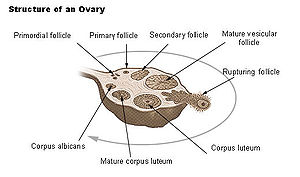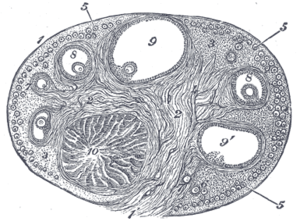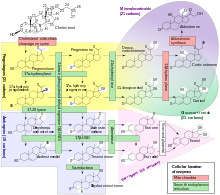- Corpus luteum
-
Corpus luteum 
x 
Section of the ovary. 1. Outer covering. 1’. Attached border. 2. Central stroma. 3. Peripheral stroma. 4. Bloodvessels. 5. Vesicular follicles in their earliest stage. 6, 7, 8. More advanced follicles. 9. An almost mature follicle. 9’. Follicle from which the ovum has escaped. 10. Corpus luteum. Gray's subject #266 1256 The corpus luteum (Latin for "yellow body") (plural corpora lutea) is a temporary endocrine structure in mammals, involved in production of relatively high levels of progesterone and moderate levels of estradiol and inhibin A. It is colored as a result of concentrating carotenoids from the diet.
Contents
Development and structure
The corpus luteum develops from an ovarian follicle during the luteal phase of the menstrual cycle or estrous cycle, following the release of a secondary oocyte from the follicle during ovulation. The follicle first forms a corpus hemorrhagicum before it becomes a corpus luteum, but the term refers to the visible collection of blood left after rupture of the follicle that secretes progesterone. While the oocyte (later the zygote if fertilization occurs) traverses the Fallopian tube into the uterus, the corpus luteum remains in the ovary.
The corpus luteum is typically very large relative to the size of the ovary; in humans, the size of the structure ranges from under 2 cm to 5 cm in diameter.[1][2]
Its cells develop from the follicular cells surrounding the ovarian follicle.[3]
Follicular structure Luteal structure Secretion Theca cells Theca lutein cells androgens[4] and progesterone[4] Granulosa cells Granulosa lutein cells progesterone,[3] estrogen[3], and inhibin A[3][4]  Steroidogenesis, with progesterone in yellow field at upper center. The androgens are shown in blue field, and aromatase at lower center - the enzyme present in granulosa lutein cells that convert androgens into estrogens (shown in pink triangle).
Steroidogenesis, with progesterone in yellow field at upper center. The androgens are shown in blue field, and aromatase at lower center - the enzyme present in granulosa lutein cells that convert androgens into estrogens (shown in pink triangle).
Like the previous theca cells, the theca lutein cells lack the aromatase enzyme that is necessary to produce estrogen, so they can only perform steroidogenesis until formation of androgens.[5] The granulosa lutein cells do have aromatase, and use it to produce estrogens, using the androgens previously synthesized by the theca lutein cells, as the granulosa lutein cells in themselves do not have the 17α-hydroxylase or 17,20 lyase to produce androgens.[5]
Once the corpus luteum regressed the remnant is known as corpus albicans.[6]
Function
The corpus luteum is essential for establishing and maintaining pregnancy in females. The corpus luteum secretes progesterone, which is a steroid hormone responsible for the decidualization of the endometrium (its development) and maintenance, respectively.
When egg is not fertilized
If the egg is not fertilized, the corpus luteum stops secreting progesterone and decays (after approximately 14 days in humans). It then degenerates into a corpus albicans, which is a mass of fibrous scar tissue.
The uterine lining sloughs off without progesterone and is expelled through the vagina (in humans and some great apes, which go through a menstrual cycle). In an estrus cycle, the lining degenerates back to normal size.
When egg is fertilized
If the egg is fertilized and implantation occurs, the syncytiotrophoblast (derived from trophoblast) cells of the blastocyst secrete the hormone human chorionic gonadotropin (hCG, or a similar hormone in other species) by day 9 post-fertilization.
Human chorionic gonadotropin signals the corpus luteum to continue progesterone secretion, thereby maintaining the thick lining (endometrium) of the uterus and providing an area rich in blood vessels in which the zygote(s) can develop. From this point on, the corpus luteum is called the corpus luteum graviditatis.
The introduction of prostaglandins at this point causes the degeneration of the corpus luteum and the abortion of the fetus. However, in placental animals such as humans, the placenta eventually takes over progesterone production and the corpus luteum degrades into a corpus albicans without embryo/fetus loss.
Content of carotenoids
The yellow color and name of the corpus luteum, like that of the macula lutea of the retina, is due to its concentration of certain carotenoids, especially lutein. In 1968, a report indicated that beta-carotene was synthesized in laboratory conditions in slices of corpus luteum from cows. However, attempts have been made to replicate these findings, but have not succeeded. The idea is not presently accepted by the scientific community.[7] Rather, the corpus luteum concentrates carotenoids from the diet of the mammal.
Additional images
-
Luteinized follicular cyst. H&E stain.
External links
- Histology at BU 18201loa
- SUNY Labs 43:05-0106 – "The Female Pelvis: The Ovary"
References
- ^ "Corpus Luteum Cyst of Pregnancy". DrSpock.com. http://www.drspock.com/article/0,1510,5335,00.html. Retrieved 2009-05-26.
- ^ Vegetti W, Alagna F (2006). "FSH and follucogenesis: from physiology to ovarian stimulation". Reproductive biomedicine Online. http://www.rbmonline.com/Article/2155. Retrieved 2009-05-26.
- ^ a b c d Page 1159 in: Boron WF, Boulpaep EL (2004). Medical Physiology: A Cellular And Molecular Approaoch. Elsevier/Saunders. pp. 1300. ISBN 1-4160-2328-3.
- ^ a b c The IUPS Physiome Project --> Female Reproductive System – Cells Retrieved on Nov 9, 2009
- ^ a b Chapter 54, The Female Reproductive System > THE OVARIAN STEROIDS, in: Boron WF, Boulpaep EL (2004). Medical Physiology: A Cellular And Molecular Approaoch. Elsevier/Saunders. pp. 1300. ISBN 1-4160-2328-3.
- ^ [1]
- ^ Brian Davis. Carotenoid metabolism as a preparation for function. Pure & Applied Chemistry, Vol. 63, No. 1, pp. 131–140, 1991. available online. Accessed April 30, 2010.
Female reproductive system (TA A09.1–2, TH H3.07.01, GA 11.1254) Internal Adnexacorpus (hemorrhagicum, luteum, albicans) · Theca of follicle (externa, interna) · Follicular antrum (Follicular fluid) · Corona radiata · Zona pellucida · Membrana granulosa · Perivitelline spaceOtherProper of ovary · Suspensory of ovarycorpus/body (Uterine cavity, Fundus) · cervix/neck (External orifice, Canal of the cervix, Internal orifice, Supravaginal portion of cervix, Vaginal portion of cervix, Cervical ectropion) · Uterine hornsGeneralExternal Mons pubis · Labia majora (Anterior commissure, Posterior commissure) · Pudendal cleft · Labia minora (Frenulum of labia minora, Frenulum of clitoris) · Vulval vestibule · Interlabial sulci · Bulb of vestibule · Vaginal orifice
vestibular glands/ducts (Bartholin's glands/Bartholin's ducts, Skene's glands/Skene's ducts)Other
Wikimedia Foundation. 2010.



